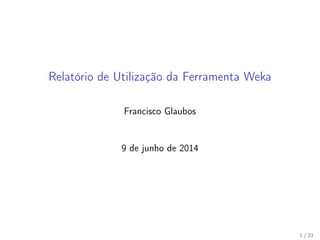
Weka Report Presentation
- 1. Relatório de Utilização da Ferramenta Weka Francisco Glaubos 9 de junho de 2014 1 / 21
- 2. A base de dados Nome: Breast Cancer Fonte: Instituto de Oncologia, Iuguslávia. Objetivo: Mostrar pacientes com câncer de mama que possuem ou não, recorrência de sintomas após o tratamento. 286 instâncias e nove atributos. 2 / 21
- 3. Class: Não-Recorrência ou Recorrência de sintomas do câncer de mama nos pacientes após o tratamento. age: Idade do paciente no momento do diagnóstico. menopause: Estado de menopausa do paciente no momento do diagnóstico. tumor-size: O tamanho do tumor em milímetros. inv-nodes: Faixa de 0 a 39 linfonodos auxiliares, que mostram o câncer de mama no momento do exame histológico. nodes-cap: A penetração do tumor na cápsula do linfonodo ou não. 3 / 21
- 4. deg-malign: Faixa de grau 1 a 3, que define o grau histológico do tumor, o nível de malignidade do tumor. breast: O câncer poder ocorrer em qualquer mama. breast-quad: Se for considerado o mamilo como um ponto central, a mama pode ser dividida em quatro quadrantes. irradiat: Se o paciente possui ou não histórico de terapia de radiação (raio-x). 4 / 21
- 5. Classificação Nayve Bayes IBK J48 Configuração padrão: Cross-validation folds = 10 5 / 21
- 6. Nayve Bayes classificou corretamente 205 e incorretamente 81 instâncias 33 classificadas como reccurence-events ⇒ no-reccurence-events 48 classificadas como no-reccurence-events ⇒ recurrence-events 6 / 21
- 7. IBK 1o teste: A classe atribuída é a predominante entre um ponto P e o vizinho mais próximo. K = 1. 7 / 21
- 8. 1 2 3 4 5 6 72.5 73 73.5 74 74.5 k-vizinhos mais próximos instânciascorretamenteclassificadas(%) 8 / 21
- 9. Figura : Resultados do método IBK com k=4. 9 / 21
- 10. J48 minNumObj = 2 e fator de confiança = 0.3 214 classificadas corretamente e 72 incorretamente. Figura : Árvore gerada pela ferramenta Weka após a execução do J48. 10 / 21
- 11. Seja c: fator de confiança e f (c) qualidade da classificação. Hipótese: limc→0 f (c) = 75.52. A ferramenta Weka não permitiu valores muito pequenos para c. 69 70 71 72 73 74 75 76 0 0.2 0.4 0.6 quantidade de instâncias corretamente classificadas (%) valordoconfidencefactor 11 / 21
- 12. Comparação: Classificação Global X Classificação Local Figura : Desempenho global dos classificadores 12 / 21
- 13. Figura : Desempenho local dos classificadores em relação a classe no-recurrence-events 13 / 21
- 14. Regras de Associação Abordagem Apriori 1o Teste: Modelo Suporte/Confiança supMin=0.5 Confiança=0.9 1. R1: inv − nodes = 0 − 2, irradiat = no, Class = no − recurrence − events ⇒ node − caps = no confiança:(0.99) 2. R2: inv − nodes = 0 − 2, irradiat = no ⇒ node − caps = no confiança:(0.97) 3. R3: node − caps = no, irradiat = no, Class = no − recurrence − events ⇒ inv − nodes = 0 − 2 confiança:(0.96) Obs.: Dificuldade de extrair classe como consequente. Confiança=0.5 14 / 21
- 15. Lift 1. R4: inv − nodes = 0 − 2 ⇒ node − caps = no, irradiat = no conf:(0.83) lift:(1.26) 2. R5: node − caps = no, irradiat = no ⇒ inv − nodes = 0 − 2 conf:(0.94) lift:(1.26) 3. R6: node − caps = no ⇒ inv − nodes = 0 − 2, irradiat = no conf:(0.8) lift:(1.25) Lift > 1 Da regra R4: os itens inv − nodes = 0 − 2 e node − caps = no, irradiat = no possuem dependência positiva (o suporte real da regra é 1.26 vezes maior que o suporte esperado). 15 / 21
- 16. Leverage, Conviction leverage: 0 a 0.25, Conviction: min=0.9 1. R7: inv − nodes = 0 − 2 ⇒ node − caps = no, irradiat = no conf:(0.83) lift:(1.26) < lev:(0.13)> conv:(1.97) 2. R8: node − caps = no, irradiat = no ⇒ inv − nodes = 0 − 2 conf:(0.94) lift:(1.26) < lev:(0.13)> conv:(4) 3. R9: inv − nodes = 0 − 2 ⇒ node − caps = no conf:(0.94) lift:(1.22) <lev:(0.12)> conv:(3.67) Dependência mais frequente: inv − nodes = 0 − 2 e node − caps = no R7=R4, R8=R5 e a regra R9 tomou a posição que era de R6 16 / 21
- 17. Clusterização: SimpleKmeans Número de clusters (K=2). Distância Euclidiana. (Distância de Manhattan não alterou os resultados) Alguns atributos não distinguiram bem os clusters 17 / 21
- 18. 1 1.5 2 2.5 3 3.5 4 80 100 120 140 160 valor do parâmetro K instânciasincorretamenteclusterizadas Figura : Qualidade da clusterização em função da variância do K. Conclusão: Execuções com K=2 clusterizam pior que K=2. A medida que se aproxima de K=2, a clusterização melhora. 18 / 21
- 19. DBSCAN Após alguns testes, o melhor valor para epsilon foi 1.5 1a Conclusão Parcial: A medida que se incrementa o minPoints, menos instâncias são clusterizadas incorretamente. 2 3 4 5 6 7 50 60 70 80 valor do minPoints instânciasincorretamenteclusterizadas 19 / 21
- 20. 2a Conclusão Parcial: Menos instâncias foram clusterizadas 2 3 4 5 6 7 10 20 30 40 50 60 valor do minPoints instânciasnãoclusterizadas Figura : Instâncias não clusterizadas com epsilon fixo em 1.5. 20 / 21
- 21. DBSCAN: Conclusão Final 1. A clusterização realmente melhora com o incremento dos minPoints? 2. o Método garante a qualidade das clusterizadas e não clusteriza outras? 21 / 21
